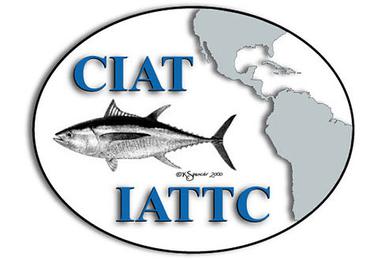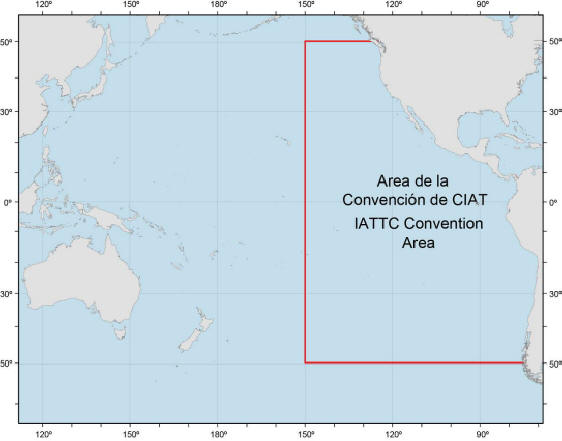ORGP - IATTC - Inter-American Tropical Tuna Commission
The main objective of the Inter-American Tropical Tuna Commission (IATTC) is to ensure the long-term conservation and sustainable exploitation of stocks regulated by the Convention in accordance with the relevant standards of international law
ORGP - IATTC - Inter-American Tropical Tuna Commission
Breadcrumbs
![]() IATTC - Inter-American Tropical Tuna Commission
IATTC - Inter-American Tropical Tuna Commission

![]() Descrição
Descrição
IATTC is the regional fisheries management organization (RFMO) responsible for the management of tuna and related fisheries in the Eastern Pacific Ocean.
The main objective of the Inter-American Tropical Tuna Commission (IATTC) is to ensure the long-term conservation and sustainable exploitation of stocks regulated by the Convention in accordance with the relevant standards of international law.
It was established by the Convention for the Establishment of an Inter-American Tropical Tuna Commission, signed by the United States of America and Costa Rica in Washington on 31 May 1949 and entered into force on 3 March 1950.
In 2003, the Convention for the Strengthening of the Inter-American Tropical Tuna Commission, known as the "Antigua Convention", which was negotiated to reinforce and replace the 1949 Convention, was opened for signature by the Parties. The Antigua Convention entered into force on August 2010.
Since 1992, IATTC has been developing an International Dolphin Conservation Program (IDCP) aimed at the progressive reduction of incidental mortality of dolphins in the purse-seine tuna fishery. This program was established by the Agreement on the International Dolphin Conservation Program (AIDCP).
![]() RFMO location and website
RFMO location and website
Inter-American Tropical Tuna Commission
IATTC Secretariat
8901 La Jolla Shores Drive
La Jolla CA 92037-1509
United States of America
Website: https://www.iattc.org/HomeENG.htm
![]() Geographical Area
Geographical Area

![]() PT Fishing gear
PT Fishing gear
Surface longline.
![]() Target species.
Target species.
Main stocks targeted by the EU fleet are tropical tuna and swordfish.
Note: the total annual catches of bigeye tuna allowed for each Member State's longliners in the IATTC Convention area are those established annually in Council Regulation (EU) fixing for certain fish stocks and groups of fish stocks, the fishing opportunities
applicable in Union waters and those applicable to Union fishing vessels in certain non-Union waters.
![]() Species with special catch, registration and control schemes
Species with special catch, registration and control schemes
Since bigeye tuna is the main target species for "flag of convenience" vessels and considering that most of the catches are exported to the territory of Contracting Parties, especially to Japan, IATTC established a Statistical Documentary Program for Bigeye Tuna, like ICCAT and IOTC.
![]() Bycatch
Bycatch
- Reduction of accidental mortality of juvenile tunas;
- Reduction and mitigation of catches of non-target species, such as sharks, swordfish and sailboats, rays, goldfish and others;
- Reduction and mitigation of accidental catches of sea turtles and seabirds:
Note: All species caught, including by-catches, must be duly recorded in the fishing logbook. Any interactions with turtles and seabirds must also be recorded on the appropriate form, indicating the location of the interaction, the species involved and the animal's status after it has been removed from the gear. Vessels operating in the region must also implement mitigation measures aimed at reducing, and if possible eliminating, interactions with turtles and sea birds.
![]() Prohibited species
Prohibited species
Sharks:
- It shall be prohibited to fish for oceanic whitetip sharks (Carcharhinus longimanus) in the IATTC Convention Area and to retain on board, tranship, land, store, offer for sale or sell any part or whole carcass of oceanic whitetip sharks caught in that area.
- When accidentally caught, specimens of oceanic whitetip sharks shall not be harmed and shall be promptly released by vessel operators.
Mobulid rays:
Union fishing vessels in the IATTC Convention Area shall not fish for mobulid rays (Mobulidae family, including the genera Manta and Mobula) and shall not retain on board, tranship, land, store, offer for sale or sell any part or whole carcass of mobulid rays caught in that area. As soon as they notice that mobulid rays have been caught, they shall promptly release them, where possible alive and unharmed.
![]() Eligibility conditions
Eligibility conditions
- Have a valid fishing license in accordance with art.º 6 of the Control Regulation (Regulation (EC) 1224/2009);
- Having number IMO if required under Union law;
- The fishing vessel is not on a list of IUU vessels adopted by a RFMO and / or the Union under the IUU Regulation;
- Have a vessel monitoring system (VMS) installed and operational;
- Have an electronic recording and reporting system installed and operational (ERS);
- Have valid certificates of navigation and compliance;
- To be on the IATTC authorized vessel list.
![]() Legislation
Legislation
- Regulation (CE) 1224/2009
- Regulation (UE) 2017/2403
- Council Regulation (EC) 520/2007
- TAC and QUOTA Regulation - Council Regulation (EU) fixing every year the fishing opportunities for certain fish stocks and groups of fish stocks, applicable in Union waters and, for Union fishing vessels, in certain non-Union waters
- IATTC Resolutions and Recommendations
![]() Observer Coverage
Observer Coverage
- A minimum coverage of 5% must be ensured on vessels larger than 20 m.



